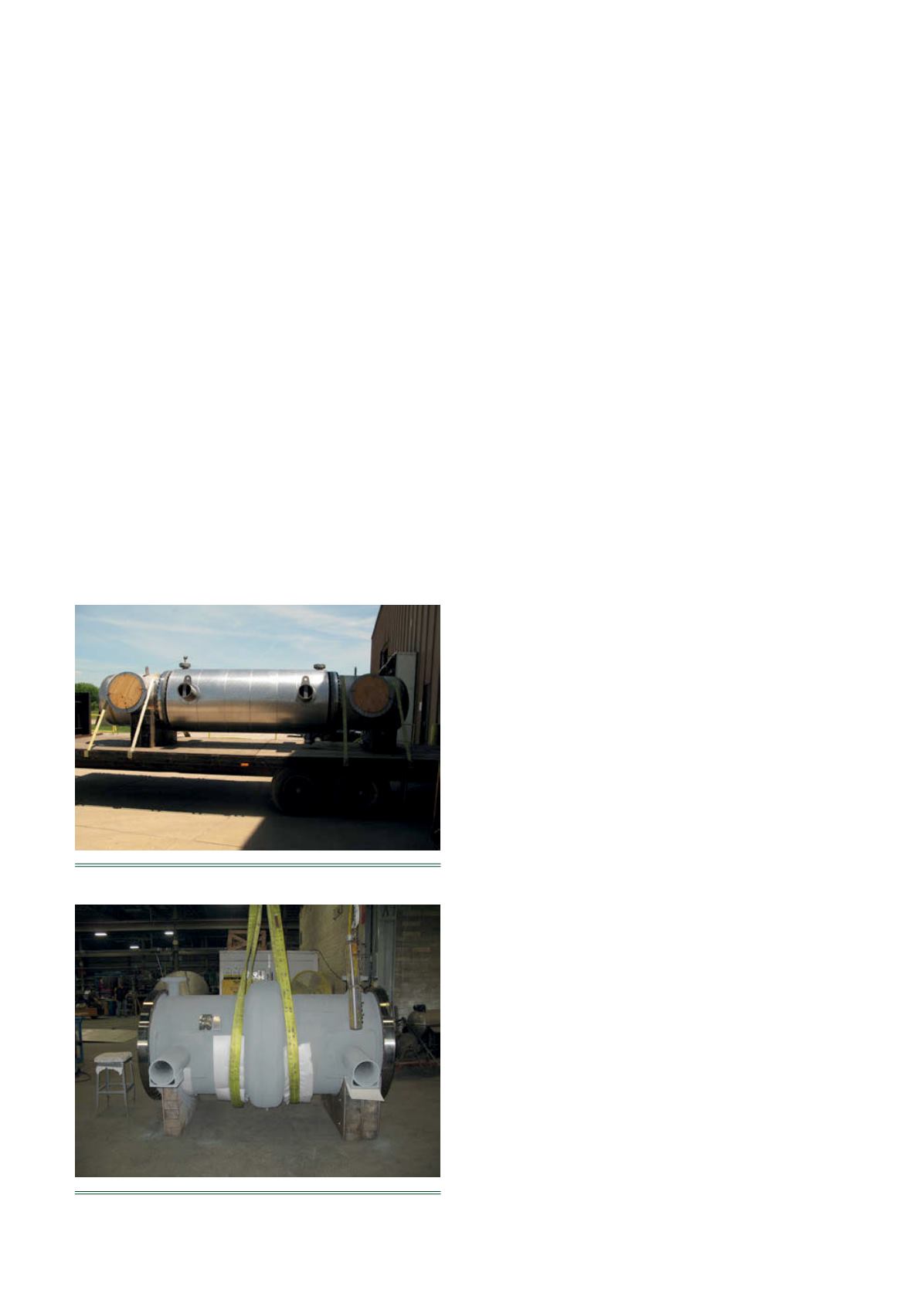
72
| WORLD FERTILIZER |
NOVEMBER 2016
article will briefly discuss the processes and the metallurgy of
the materials of construction. Emphasis will be placed on the
production of nitric acid, since this is where the greatest
potential for corrosion occurs and where the corrosion
resistance offered by the reactive metals – titanium and
zirconium – becomes very important. In this, titanium and
zirconium are used to prevent or minimise corrosion, resulting in
a long production life for the equipment.
Urea production
In the urea production plant, a stream of carbon dioxide is mixed
with a stream of ammonia and converted into urea (CO(NH
2
)
2
. As
this reaction takes place, no really corrosive conditions are
present in the system so no reactive metals are necessary to
combat corrosion. Most of the equipment at urea plants is either
carbon steel or a low-grade austenitic stainless steel, such as
304L or 316L. Once the urea is produced, it can be stored in
carbon steel vessels (protected by addition of corrosion
inhibitors) and then transferred to another part of the fertilizer
plant, where it can be combined with the nitric acid to
manufacture urea ammonium nitrate, which is used as a
nitrogen-based fertilizer.
Nitric acid production
Nitric acid can be produced in three different methods: a single
medium-pressure process, a single high-pressure process or a
dual-pressure process. Nitric acid is a strong, highly corrosive
acid, primarily used (roughly 80%) to make synthetic
nitrogen-based, commercial fertilizer. Commercial nitric acid
plants in the US are centred primarily in the agricultural areas of
the country: the Midwest, South Central and Gulf Coast. Most of
these plants are attached to a fertilizer plant to minimise the
transportation of the acid, reducing the cost and the potential
for acid spills. The acid produced for the fertilizer industry is in
the weak acid range of 50 – 65% strength.
In this stage, the nitric acid combines with the high
temperatures and pressures to develop a highly corrosive liquid
and gas stream. This is where the high corrosion resistance of the
reactive metals, titanium and zirconium, can be cost-effectively
used for the fabrication of equipment to enable a long life in this
aggressive environment. Cooler condensers and tail gas
pre-heaters must withstand the most aggressive environments in
the nitric acid plant, where temperatures are high and acid
concentrations vary as the gas is cooled and nitric acid
condenses onto surfaces at very high concentrations before
being diluted by the overall gas/liquid mixture.
Titanium and zirconium have been used in the nitric acid
industry for over 35 years. Titanium (Ti) and zirconium (Zr) exhibit
excellent corrosion resistance because of their ability to form an
adherent, dense, stable oxide layer on their surface. Once this
layer (TiO
2
or ZrO) develops, it effectively inhibits the access of
the corrosive to the underlying pure metal, stopping any further
corrosion from occurring. This mechanism is the exact opposite
to carbon steel, where iron oxide (red rust) forms and flakes off,
allowing the corrosive to have unlimited access to the
underlying metal and resulting in rapid, uniform corrosion.
Titanium is used for producing nitric acid in areas where
stainless steels have exhibited significant corrosion and titanium
has shown virtually no corrosion. Titanium offers excellent
resistance over the full concentration range of nitric acid at
temperatures below 212˚F. At higher temperatures, however,
titanium’s corrosion resistance is highly dependent on the purity
of the nitric acid. In hot, very pure solutions or vapour
condensates of nitric acid, significant general corrosion may
occur in the 20 – 70 Wt% range. However, the presence of even
a small amount of metallic elements (silicon, iron, chromium,
platinum, etc.) in the nitric acid can greatly extend the range of
use for titanium. Even titanium ions in the nitric acid (perhaps
from previous corrosion) can reduce the corrosiveness and
extend the range of use for titanium.
Every metal has its limits in terms of what chemistries it can
be effective in; and titanium is no different. As the nitric acid
concentration and temperature increases, the mechanism of
protection for titanium breaks down, resulting in an increased
corrosion rate. This necessitates the use of a more resistant
metal, zirconium. Zirconium is resistant to corrosion by nitric acid
even up to concentrations of 99 Wt% and temperatures
considerably over the boiling point. So, for weak acid areas at
lower temperatures, titanium can be used for cooler condensers
and tail gas preheaters. But, in the processes where higher
concentrations of nitric acid or higher temperatures are found,
zirconium becomes the metal of choice for corrosion-resistant
cooler condensers and tail gas preheaters.
Because of this excellent corrosion resistance in oxidising
conditions (where the oxide film can form), these reactive
metals are used in a wide variety of chemical plants as
corrosion-resistant equipment. In addition to nitric acid plants,
titanium has been successfully used for over 40 years in
Figure 1.
Titanium cooler condenser.
Figure 2.
Zirconium cooler condenser.


